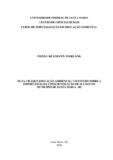| dc.contributor.advisor | Merck, Ana Maria Thielen | |
| dc.creator | Werlang, Tiessa Kulmann | |
| dc.date.accessioned | 2018-11-13T14:43:41Z | |
| dc.date.available | 2018-11-13T14:43:41Z | |
| dc.date.issued | 2018-08-31 | |
| dc.date.submitted | 2018 | |
| dc.identifier.uri | http://repositorio.ufsm.br/handle/1/14824 | |
| dc.description | Monografia (especialização) - Universidade Federal de Santa Maria, Centro de Ciências Rurais, Curso de Especialização em Educação Ambiental, RS, 2018. | por |
| dc.description.abstract | The riparian forests play numerous essential functions in the environment, being considered as a permanent preservation area by the Brazilian Forest Code. However, due to the exploitation of the natural resources in Brazil, where intense exploitation and devastation take place, the suppression of this ciliary vegetation has enormous consequences for the rivers and all the biodiversity. The objective of the present work was to raise awareness and to bring to the knowledge of the students of the 3rd year of the High School of the Walter Jobim State High School in the municipality of Santa Maria, RS, concepts such as: what is a riparian forest, its importance for the environment and its characteristics. In addition, it sought to emphasize socio-environmental problems generated, changes and questions about the new Forest Code in order to arouse interest for responsible citizenship and disseminate Environmental Education in the community in which they live. The research was a bibliographical one and an analysis of a questionnaire answered by the students in order to investigate their conceptions about the topic ciliary forest. Given the results obtained with the students' responses to the questionnaire, it was found that many students, although they had already heard about Environmental Education, knew little about what it was really about and approximately 77% of the class had not heard of ciliary forest and its benefits. They also did not know the existence of changes in the Forest Code and did not know the numerous problems that the devastation of this vegetation affects the big cities. Based on the data generated, the great majority of the students realized the real importance of preserving the environment, especially the care with the riparian forests, and the fundamental role of Environmental Education. However, it is still necessary to work further on Environmental Education in the classroom so that there is a necessary means for the construction of responsible individuals that promote a healthy quality of life and contribute to sustainable development, as well as provide information aimed at awareness of the communities involved. The research brought as theoretical foundation authors such as Giani Motin Mocellin, Francisco Marcondes De Almeida, Alcione Adame, Elaine Oliveira Praes, Rachel Trajber and Marcos Sorrentino. | eng |
| dc.language | por | por |
| dc.publisher | Universidade Federal de Santa Maria | por |
| dc.rights | Acesso Aberto | por |
| dc.rights | Attribution-NonCommercial-NoDerivatives 4.0 International | * |
| dc.rights.uri | http://creativecommons.org/licenses/by-nc-nd/4.0/ | * |
| dc.subject | Educação ambiental | por |
| dc.subject | Mata ciliar | por |
| dc.subject | Conscientização | por |
| dc.title | Mata ciliar e educação ambiental: um estudo sobre a importância da conscientização de alunos no município de Santa Maria – RS | por |
| dc.title.alternative | Mata ciliar and environmental education: a study on the importance of student awareness in the municipality of Santa Maria - RS | eng |
| dc.type | Trabalho de Conclusão de Curso de Especialização | por |
| dc.degree.local | Santa Maria, RS, Brasil | por |
| dc.degree.specialization | Educação Ambiental | por |
| dc.description.resumo | As matas ciliares desempenham inúmeras funções essenciais no meio ambiente, sendo consideradas como área de preservação permanente pelo Código Florestal Brasileiro. Porém, em decorrência da exploração dos recursos naturais no Brasil, onde acontecem intensa exploração e devastação, a supressão desta vegetação ciliar traz enormes consequências para os rios e toda a biodiversidade. O presente trabalho objetivou, através da Educação Ambiental, conscientizar e levar ao conhecimento dos alunos do 3º ano do Ensino Médio da Escola Estadual de Ensino Médio Walter Jobim no município de Santa Maria – RS conceitos como: o que é mata ciliar, sua importância para o meio ambiente e suas características. Além disso, buscou enfatizar problemas socioambientais gerados, alterações e questionamentos sobre o novo Código Florestal a fim de despertar interesse para uma cidadania responsável e disseminar a Educação Ambiental na comunidade em que vivem. A pesquisa foi de cunho bibliográfico e uma análise de um questionário respondido pelos alunos a fim de investigar suas concepções acerca do tema mata ciliar. Ante aos resultados obtidos com as respostas dos alunos ao questionário, constatou-se que muitos estudantes, apesar de já terem ouvido falar em Educação Ambiental, pouco sabiam sobre o que realmente se tratava e aproximadamente 77% da turma não tinha ouvido falar em mata ciliar e seus benefícios. Também desconheciam a existência de mudanças no Código Florestal e não sabiam os inúmeros problemas que a devastação desta vegetação afeta as grandes cidades. Com base nos dados gerados, a grande maioria dos alunos percebeu a real importância de preservar o meio ambiente, principalmente o cuidado com as matas ciliares, e o fundamental papel da Educação Ambiental. No entanto, ainda é necessário trabalhar ainda mais a Educação Ambiental em sala de aula para que haja um meio necessário para a construção de indivíduos responsáveis que promovam uma sadia qualidade de vida e contribuam para um desenvolvimento sustentável, bem como proporcionar informação direcionada para a conscientização das comunidades envolvidas. A pesquisa trouxe como embasamento teórico autores como Giani Motin Mocellin, Francisco Marcondes De Almeida, Alcione Adame, Elaine Oliveira Praes, Rachel Trajber e Marcos Sorrentino. | por |
| dc.publisher.country | Brasil | por |
| dc.publisher.initials | UFSM | por |
| dc.subject.cnpq | CNPQ::CIENCIAS HUMANAS::EDUCACAO | por |
| dc.publisher.unidade | Centro de Ciências Rurais | por |



